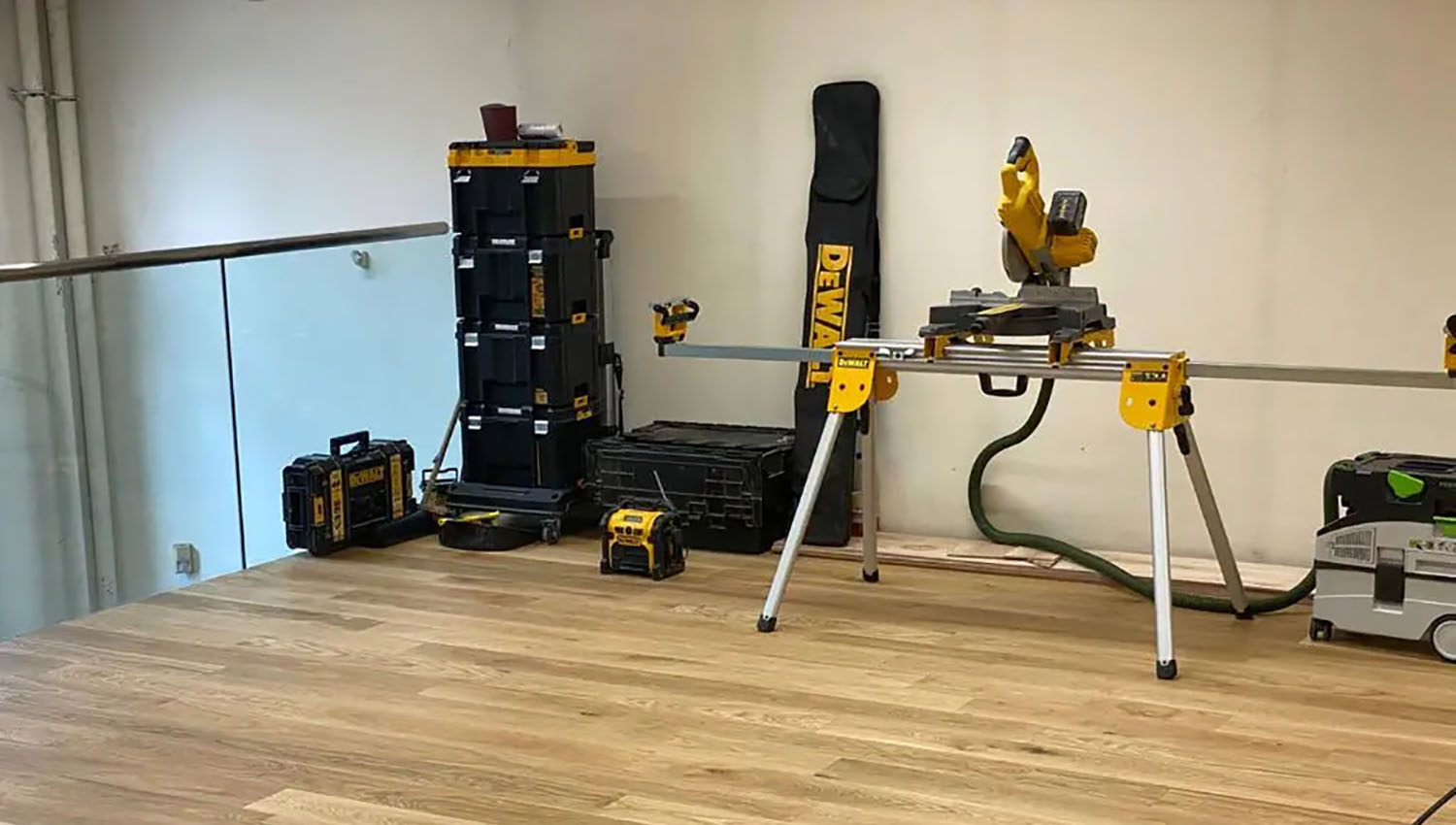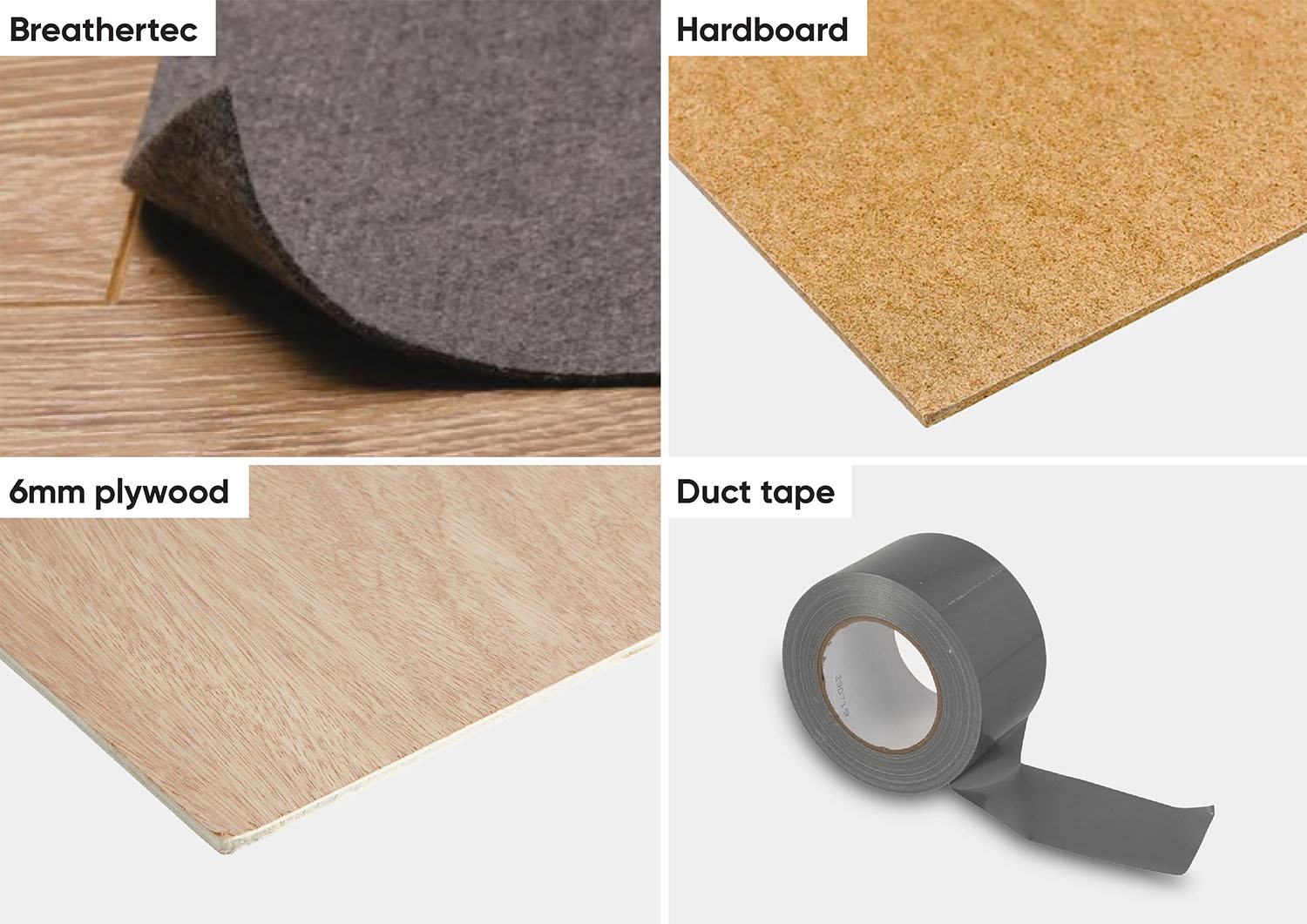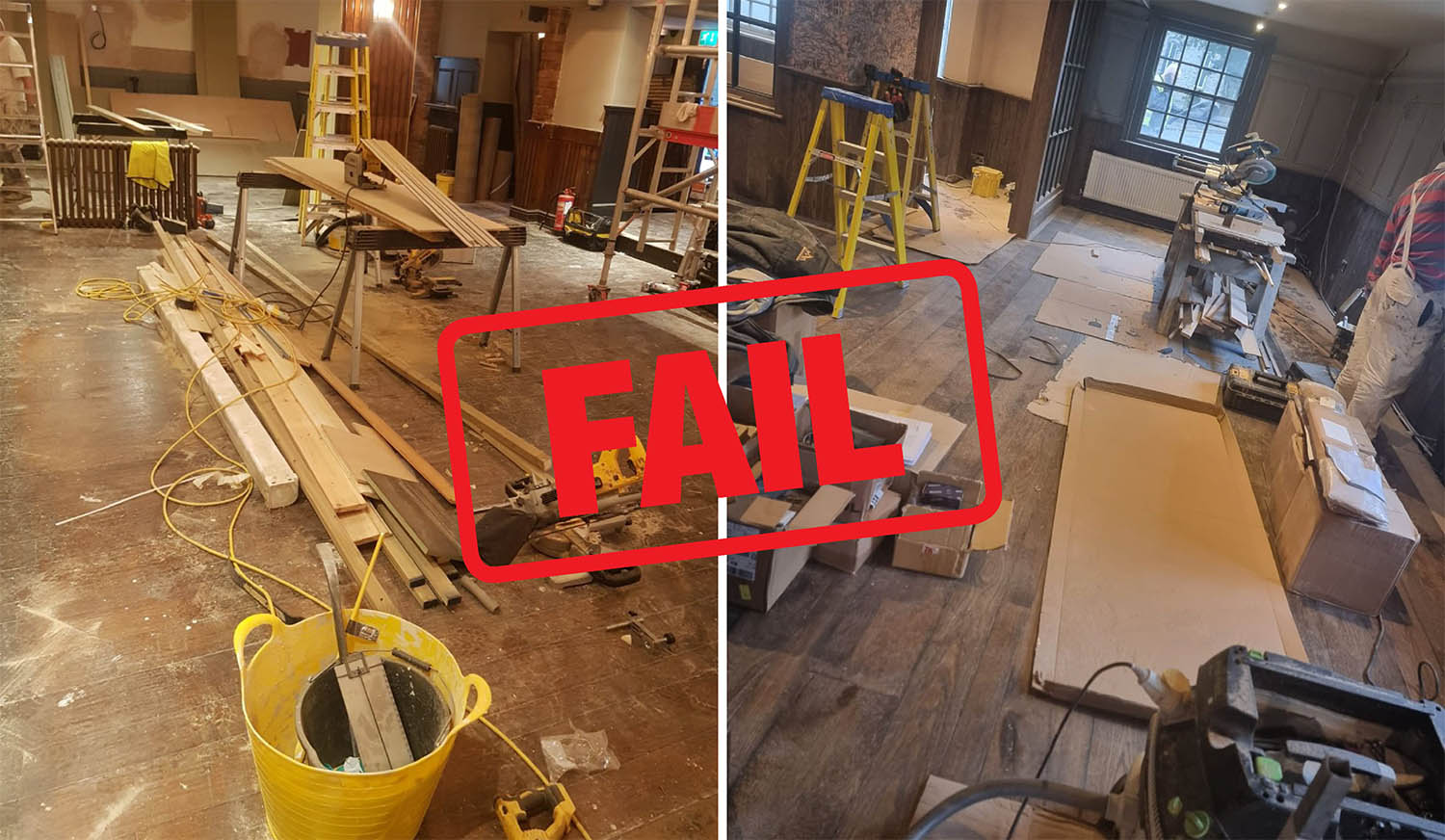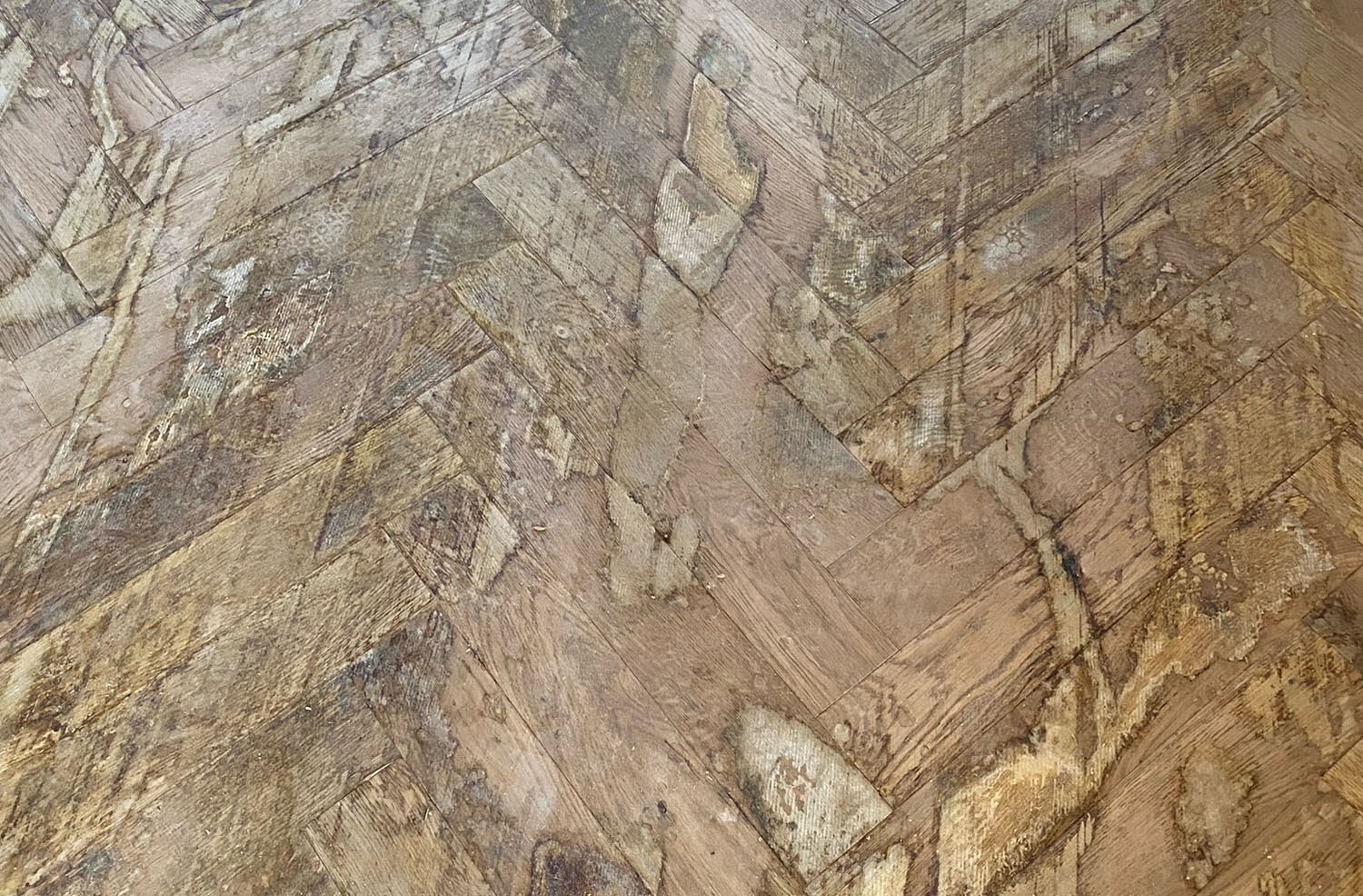Hardwood floors are extremely durable, however, they are not indestructible. Construction work and renovation can put them at great risk of damage, so take these precautions to maintain a stunning look by the end of your project.

If your wood flooring has not been installed yet, consider when the best time in the construction process will be. Installing hardwood flooring towards the end of your project offers several benefits.
Rather than protecting the floor, this completely eliminates the potential risks of trades’ heavy tools and equipment, ensuring your floors come out pristine. It also removes risks during finishing touches like painting, preventing splatters from ruining your floors' appearance.
While this can be the best option in some scenarios, not all are this lucky. If work must be done over existing hardwood floors, extra precautions need to be taken.
Establishing safe walking routes for workers is essential to prevent damage to your wood floors, especially when high foot traffic is expected. Follow these steps to create clear pathways:
By planning well-defined walking routes, you ensure a smooth construction process while preserving your hardwood floors' beautiful appearance.
Implementing a protection plan becomes crucial when any heavy construction is taking place on your hardwood floor. Failure to do so exposes your floor to severe and costly damage.

Here’s a multi-layer approach to safeguard your hardwood floors:
Begin by laying down a felt underlayment, around 2 to 3 mm thick, designed specifically for wood flooring. This layer serves as a vapour barrier, allowing moisture to escape while shielding your hardwood floors from potential harm.
Crucially, ensure each layer is securely sealed with duct tape. Properly sealing joints prevents the infiltration of liquids, preserving the integrity of your protective finishes and ultimately safeguarding your hardwood floors from potential damage.

As your renovation project nears completion, it’s important to keep your floors protected. The risk of damage when decorating is a real concern. This is where Bufallo board (also referred to as ram board) comes in.
Buffalo board is a heavyweight solution designed to shield against light impacts, paint spills, and other damage risks that accompany those final touches. It also boasts impressive water-repellent properties, adding an extra layer of defence to ensure your hardwood floors maintain their flawless look.
While covering the entire floor with Bufallo board might be overkill, strategic placement is highly effective. Consider laying Bufallo board in areas that are anticipated to have high foot traffic or where paint work is taking place.
Despite their perceived effectiveness, these sheets hinder the wood floor’s ability to breathe, potentially leading to moisture-related issues.
Also, plastic sheets do not provide adequate protection against sharp objects such as screws and nails. In the event that these items are accidentally stepped on, they can penetrate through the plastic sheeting, damaging the pre-finished wood floor surface. This underscores the importance of using the appropriate protective materials.
The below image is an example of what can happen to your floor when it is not able to breathe during construction.

Here, the builders layed black plastic corrugated sheets over a new engineered herringbone floor and left it in place for several weeks while renovation work took place. Coming to the completion of the job, the corrugated plastic sheeting was lifted to the client’s horror - the flooring had started to decompose due to underfloor heating been left on while the flooring was covered - trapping moisture between the floor and the corrugated sheeting.
Construction work can be tough on hardwood floors. Dust and debris can seep into the wood, causing harm that's hard to undo. If the air isn't moving well, things get even worse as dirt and dust gather on your floor.
So, how do you keep your site clean during construction?
Regularly eliminate debris and dust from the construction area and swiftly address spills as they occur to prevent any moisture from infiltrating your floors.
Guarantee sufficient airflow to minimise dust and fumes building up. Indoor air quality can be improved by adding an air purifier.
Use barriers to divide different areas of construction and shield your floors from potential damage. You can also cover HVAC vents to prevent debris from getting inside and causing harm.
Keeping wood floors clean is vital during building work to prevent damage. However, using incorrect cleaning techniques can leave hardwood floors with stained or scratched surfaces. Don’t make this mistake yourself.
Plaster dust and wet plaster pose a significant threat to wood floors. The combination of water and plaster dust leads to a harmful reaction that penetrates the wood grain and compromises the finish.
If plaster dust is cleaned up with water and a mop it will lead to the plaster dust becoming wet and corrosive, resulting in a floor marred by unsightly stains and discolouration.
Ideally, your wood floor should never come into contact with any plaster. But in the circumstance that plaster needs to be cleaned from the floor, ensure it stays dry throughout the process, this can be done using a powerful hoover with a brush.
By following these steps, you can effectively shield valuable hardwood floors from potential harm during construction work.
Our new brochure is packed full of hundreds of new products, creative design solutions and inspirational flooring ideas.
DOWNLOAD BROCHURE (PDF)We recommend booking in advance before your visit
JackEvie Floor Collections
Unit 21, Calibre Industrial Park,
Laches Close, Four Ashes,
Wolverhampton WV10 7DZ
| Monday | 9:00am – 4:00pm |
| Tuesday | 9:00am – 4:00pm |
| Wednesday | 9:00am – 4:00pm |
| Thursday | 9:00am – 4:00pm |
| Friday | 9:00am – 4:00pm |
| Saturday | Closed |
| Sunday | Closed |